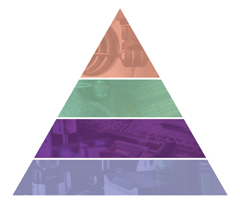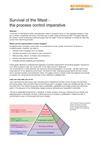芯出し・段取り計測
プローブ計測を駆使した自動段取りで、手作業よりも作業時間を劇的に短縮。
Productive Process Pyramid™ の芯出し・段取り計測層では、切削を開始する前に機械、パーツ、工具の関係を設定します。加工開始直前に予測して措置を適用する層です。
最初から正確な切削を実現

芯出し・段取り計測層では、ワークの位置、工具の長さや径などの誤差の原因に対処し、公差外パーツを防ぎます。
加工開始直前に予測して措置を適用する層です。
工具計測で確立できる項目
- 主軸ゲージラインからの工具長 (高さオフセットの算出および工具長の指定公差チェックのため)
- 回転時の直径 (工具サイズのオフセット設定のため)
パーツ計測で確立できる項目
- パーツの固有情報 (適切な NC プログラム選択のため)
- 基準形状の位置 (ワーク座標系設定のため)
- ビレット/ワークのサイズ (面位置と粗切削シーケンス判断のため)
- 機械軸に対するパーツの向き (座標回転設定のため)
段取り・芯出しで確立できる項目
- 回転軸、インデキサ、パーツの位置決めと固定に必要な治具のアライメント
- インデキサの回転の中心位置、治具の参照位置
予測型制御
プローブ計測による自動芯出しなら、かかる時間を手動時の 10 分の 1 に短縮でき、切削加工の時間を増やすことが可能です。
計測に要する時間が明確なため、それに応じて計画を立てられます。
機上計測を使用するワーク芯出しおよび段取り工程は、プログラムですべて制御が可能です。そのため、熟練した作業員が計測、計算、オフセット設定をする必要がなくなります。
金属切削作業を高い繰り返し精度で高速自動設定するうえで欠かせないのが、レニショーのワーク計測プローブ、工具計測システム、Productivity+™ などです。
資料
-
 カタログ: パンフレット: 生産効率を向上させるための計測ソリューション
カタログ: パンフレット: 生産効率を向上させるための計測ソリューション
プロセス制御のエキスパート企業が、貴社の生産工程のパフォーマンス変革をお手伝いします
-
 White paper: Survival of the fittest - the process control imperative [en]
White paper: Survival of the fittest - the process control imperative [en]
In tough times, manufacturers focus on reducing their operating costs, but may not be able to afford to spend their way out by buying more productive machinery. With that pathway closed, what are the opportunities for radically reducing costs without replacing existing machines? This paper explores four areas where substantial savings can be found if firms are prepared to change the way they control their machining processes.

